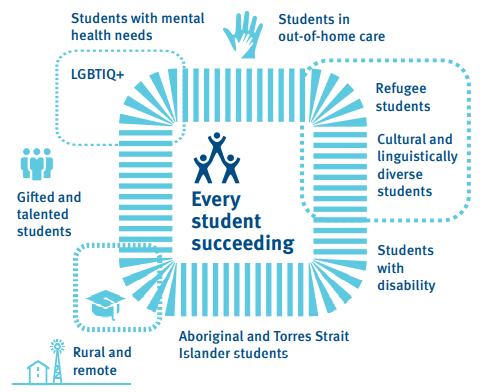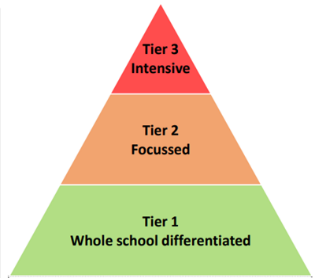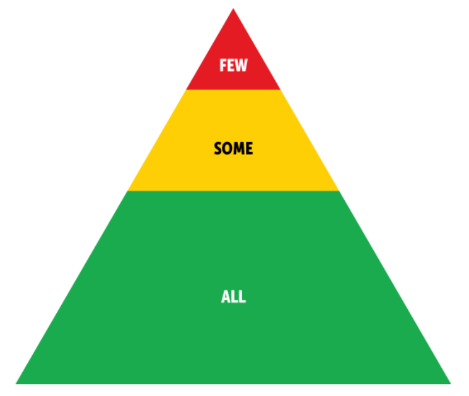Warm welcome to The Gap State School community.
Our school community strives to uphold our vision for all our students.
Empowered and successful students, reaching their potential in an inclusive and welcoming community.
The Queensland Department of Education's Inclusive Education policy describes inclusion as all students, from all social, cultural, community and family backgrounds, and of all identities and all abilities accessing and fully participating in learning, alongside their similar-aged peers, supported by reasonable adjustments and teaching strategies tailored to meet their individual needs.
At The Gap State School we are all inclusive educators who believe every student can learn and that responding to the diverse learning needs of all students is central to our teaching.
We:
- use diversity and differences as a tool for improving the quality of our
 teaching.
teaching. - refine what we create to mitigate barriers to provide educational opportunities for all students.
- work in Student Support Teams sharing competencies, to develop mutually supportive and accountable partnerships to improve student outcomes and promote the wellbeing of us all.
- use our Multi-Tier System of Support and Personalised Learning Framework to create the right support to do right by all our students.
Multi-Tier System of Support
This proactive framework provides a model of support for all students, consisting of 3 tiers of intervention. The tiers represent levels of intervention.
Multi Tier System of Support centres on a strong foundation of universal, evidence-based approaches which increase in intensity and individualisation. The result is a continuum of resources, strategies and structures varying in frequency, duration and intensity in response to students' learning-, behaviour-, and well-being needs.
Tier 1 encompasses whole school quality differentiated instruction and supports all students across all school settings. It is robust, proactive and positive.
 Tier 2 comprises of supplementary instruction through focussed interventions that are delivered to small groups, for a specific purpose, over a defined period of time. Students receive Tier 2 supports in addition to Tier 1 to respond to their specific needs.
Tier 2 comprises of supplementary instruction through focussed interventions that are delivered to small groups, for a specific purpose, over a defined period of time. Students receive Tier 2 supports in addition to Tier 1 to respond to their specific needs.
Tier 3 delivers intensive and highly personalised interventions often delivered 1:1 over an extended period of time, possibly for the entire length of schooling. Intensive, individualised instruction or support may occur in a highly structured or specialised manner enabling students to access learning through specialised equipment, highly modified classroom and school environments and extensive support from specialist staff. Complex case management may be required for students receiving Tier 3 supports.
Personal Learning Framework
In order to create an inclusive environment, adjustments may need to be made to help a student or group of students participate on the same basis as other students. The adjustment made will reflect the assessed individual needs of the student and can be made in both the classroom and whole school setting.
We utilise practices supporting the four elements of Personalised Learning. They are ongoing and embedded, throughout the school year, with feedback informing continuous improvements to program delivery.
The four elements in Personalised Learning, which reflect the teaching and learning cycle are:
- Consult and collaborate with the student and/or their parents, guardians or carers
- Assess and identify the needs of the student
- Provide adjustments to the students to address their identified needs
- Monitor and review the impact of the adjustments provided
1. Consult and collaborate with the student and/or their parents, guardians or carers
Teachers or school teams:
- engage with the student and their parents, guardians or carers to identify the student's aspirations, goals, strengths and needs.
- seek expert advice from external agencies, such as support providers, specialists, health professionals and advocates, where applicable, on the student's needs including medical, personal, physical, communication, sensory and learning needs. Ensure advice is made available to all relevant staff and that the storage and distribution of any personal information complies with privacy requirements.
- undertake ongoing consultation as the student's needs change.
2. Assess and identify the needs of the student
Teachers or school teams:
- draw on available evidence, including consultation with student and their parents, guardians or carers to identify areas in which the student requires adjustments or further support (these can relate to curriculum access, participation, behaviour support, medical needs and/or learning supports). Records of the analysis of this data provide a benchmark for ongoing assessment.
- identify options, interventions and other adjustments to curriculum, learning activities and the environment that address identified learning or other needs, building on the student's strengths.
- seek expert advice from external agencies, such as support providers, specialists, health professionals and advocates, if needed when assessing and designing adjustments.
3. Provide adjustments to the student to address their identified needs
Teachers or school teams:
- implement adjustments to help the student participate on the same basis as other students.
- embed personalised adjustments and differentiated classroom practice within teaching and learning programs and whole-school activities occurring outside the classroom.
4. Monitor and review the impact of the adjustments provided
Teachers or school teams:
- regularly review the effectiveness of personalised adjustments, including adjustments being provided to the environment, to ensure they are still relevant and required for the student and to determine whether further support measures need to be incorporated. Review of adjustments incorporates consultation with the student and their parents, guardians or carers.
Whole of school commitment
The Gap State School is committed to the success and wellbeing of every student with disability through each stage of learning in an inclusive and equitable education system.
Our school leaders, classroom teachers and specialist support staff are committed to providing high quality learning for students with a disability.
We are supported in house by:
- Guidance Officer - Nikki Triggell
- Speech Language Pathologist - Wendy Turner
- English as an Additional Language or Dialect Teacher – Sharon Liddell
- Specialist Support Staff - Danielle Panteli, Lauren Vanderzee, Lisa Evans
- Head of Special Education - Meegan Goodfellow-Kerr
We are also able to access a wide range of specialist staff from regional offices including therapists, nurses, Principal Advisors Autism, Principal Advisors Mental Health, Reading and Writing Coaches, wellbeing professionals, Principal Advisors Inclusion, Auslan Coaches and Advisory Visiting Teachers.
Our work is supported by the Students with Disability- Reasonable Adjustments Resourcing model.
Reasonable Adjustment Resourcing (RAR)
All schools must make reasonable adjustments under the Disability Discrimination Act 1992 (DDA) the Disability Standards for Education 2005 (DSE) and the Anti-Discrimination Act 1991 (Qld) to enable all students with disability to access and participate in education on the same basis as their peers without disability.
Reasonable adjustments are actions taken to ensure students with disability can access education equitably, and are essential to a student's success and wellbeing.
Adjustments are individualised to the student and vary in frequency and intensity. The levels of adjustments made are reported by state schools annually through the Nationally Consistent Collection of Data on School Students with Disability (NCCD) in accordance with NCCD National Guidelines.
RAR is based on the Nationally Consistent Collection of Data on School Students with Disability and targets resources to all disabilities as defined under the DDA including dyslexia, attention deficit hyperactivity disorder (ADHD), mental health conditions and fetal alcohol spectrum disorder, as well as autism, intellectual disability, and vision, hearing and physical impairments.
Resources are provided to schools based on the level of reasonable adjustments made for students, regardless of their type of disability.